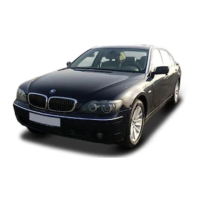OverviewControlsDriving hintsCommunication NavigationEntertainmentMobilityReference
119
trical system and transmission may be
damaged.
<
Brakes
Braking with ABS
You use ABS most effectively by applying
maximum brake pressure in situations
which call for this full braking. Since the
car remains steerable, you can avoid
obstacles by turning the steering wheel as
smoothly as possible.
The pulsating sensation at the brake pedal,
combined with the sound of the hydraulic
system operating, indicates that ABS is
intervening.
Do not rest your foot on the brake
pedal while the car is in motion. Even
slight continuous pressure on the brake
pedal could cause overheating, brake pad
wear or even brake system failure.
<
Disc brakes
Wet roads
In damp weather or heavy rain it is advis-
able to apply the brakes with light pedal
pressure every few kilometres/miles. When
doing so, make sure that no other road-
user is endangered. The resulting heat
dries the brake discs and pads. The braking
force will then be available immediately if
needed.
Downhill gradients
To avoid any risk of brake fade when
descending long or steep hills, select the
gear which calls for a minimum amount of
braking.
The engine braking effect can be enhanced
by selecting a lower gear in the automatic
transmission's manual mode, right down to
1st gear if necessary, see page 63. This
avoids overburdening the brakes.
Corrosion
If the car is used only for short distances, is
not used for lengthy periods or is subjected
to only minor loads, the brake discs will be
particularly susceptible to corrosion and
the brake pads will collect dirt; this is
because the necessary brake pressure for
a self-cleaning effect has not been gener-
ated.
When the brakes are applied, corroded
discs tend to judder, and even lengthy
brake applications usually fail to eliminate
this effect entirely.
Never drive with the automatic trans-
mission in the neutral position
selector lever pressed towards N or with
the engine switched off, as the engine's
braking action is lost with the transmission
in neutral and there will be no power assist-
ance to the brakes and steering while the
engine is switched off.
Make sure that the full travel of the brake
and accelerator pedals is not obstructed by
floor mats, carpets or other objects.
<
Brake pads
The warning light for the brake pads
lights up and a message appears in
the Check Control. Observe the
supplementary instructions in the control
display.
The brake pads have reached the safe limit
for pad wear. Visit BMW Service without
delay to have them changed.
In the interests of your own safety,
use only brake pads that BMW has
approved for this particular car model or
version. BMW is unable to assess the suit-
ability of brake pads it has not approved
and cannot therefore guarantee their
safety.
<
ba.book Page 119 Thursday, December 19, 2002 8:13 PM

